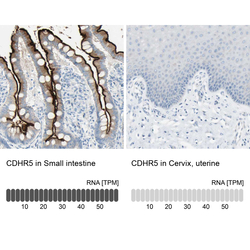Antibody data
- Antibody Data
- Antigen structure
- References [6]
- Comments [0]
- Validations
- Immunohistochemistry [1]
Submit
Validation data
Reference
Comment
Report error
- Product number
- HPA009081 - Provider product page

- Provider
- Atlas Antibodies
- Proper citation
- Atlas Antibodies Cat#HPA009081, RRID:AB_1079428
- Product name
- Anti-CDHR5
- Antibody type
- Polyclonal
- Description
- Polyclonal Antibody against Human CDHR5, Gene description: cadherin-related family member 5, Alternative Gene Names: FLJ20219, MU-PCDH, MUCDHL, MUPCDH, Validated applications: IHC, Uniprot ID: Q9HBB8, Storage: Store at +4°C for short term storage. Long time storage is recommended at -20°C.
- Reactivity
- Human
- Host
- Rabbit
- Conjugate
- Unconjugated
- Isotype
- IgG
- Vial size
- 100 µl
- Concentration
- 0.3 mg/ml
- Storage
- Store at +4°C for short term storage. Long time storage is recommended at -20°C.
- Handling
- The antibody solution should be gently mixed before use.
Submitted references Phage Immunoprecipitation‐Sequencing Reveals CDHR5 Autoantibodies in Select Patients With Interstitial Lung Disease
A heterologous in-cell assay for investigating intermicrovillar adhesion complex interactions reveals a novel protrusion length-matching mechanism
The small EF-hand protein CALML4 functions as a critical myosin light chain within the intermicrovillar adhesion complex
Actin Dynamics Drive Microvillar Motility and Clustering during Brush Border Assembly
ANKS4B Is Essential for Intermicrovillar Adhesion Complex Formation
Proteomic analysis of the enterocyte brush border
Upadhyay V, Yoon Y, Vazquez S, Velez T, Jones K, Lee C, Law C, Wolters P, Lee S, Yang M, Farrand E, Noth I, Strek M, Anderson M, DeRisi J, Sperling A, Shum A
ACR Open Rheumatology 2024;6(9):568-580
ACR Open Rheumatology 2024;6(9):568-580
A heterologous in-cell assay for investigating intermicrovillar adhesion complex interactions reveals a novel protrusion length-matching mechanism
Weck M, Crawley S, Tyska M
Journal of Biological Chemistry 2020;295(48):16191-16206
Journal of Biological Chemistry 2020;295(48):16191-16206
The small EF-hand protein CALML4 functions as a critical myosin light chain within the intermicrovillar adhesion complex
Choi M, Graves M, Matoo S, Storad Z, El Sheikh Idris R, Weck M, Smith Z, Tyska M, Crawley S
Journal of Biological Chemistry 2020;295(28):9281-9296
Journal of Biological Chemistry 2020;295(28):9281-9296
Actin Dynamics Drive Microvillar Motility and Clustering during Brush Border Assembly
Meenderink L, Gaeta I, Postema M, Cencer C, Chinowsky C, Krystofiak E, Millis B, Tyska M
Developmental Cell 2019;50(5):545-556.e4
Developmental Cell 2019;50(5):545-556.e4
ANKS4B Is Essential for Intermicrovillar Adhesion Complex Formation
Crawley S, Weck M, Grega-Larson N, Shifrin D, Tyska M
Developmental Cell 2016;36(2):190-200
Developmental Cell 2016;36(2):190-200
Proteomic analysis of the enterocyte brush border
McConnell R, Benesh A, Mao S, Tabb D, Tyska M
American Journal of Physiology-Gastrointestinal and Liver Physiology 2011;300(5):G914-G926
American Journal of Physiology-Gastrointestinal and Liver Physiology 2011;300(5):G914-G926
No comments: Submit comment
Supportive validation
- Submitted by
- Atlas Antibodies (provider)
- Enhanced method
- Orthogonal validation
- Main image

- Experimental details
- Immunohistochemistry analysis in human small intestine and cervix, uterine tissues using Anti-CDHR5 antibody. Corresponding CDHR5 RNA-seq data are presented for the same tissues.
- Sample type
- Human
- Protocol
- Protocol
 Explore
Explore Validate
Validate Learn
Learn Immunohistochemistry
Immunohistochemistry